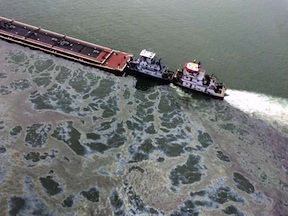The following is text from a news release from the National Transportation Safety Board (NTSB):
(WASHINGTON) — This is a synopsis from the NTSB’s report and does not include the board’s rationale for the conclusions, probable cause, and safety recommendations. NTSB staff is currently making final revisions to the report from which the attached conclusions and safety recommendations have been extracted. The final report and pertinent safety recommendation letters will be distributed to recommendation recipients as soon as possible. The attached information is subject to further review and editing.
Executive summary
On March 22, 2014, about 1235 Central Daylight Time, the 607-foot-long bulk carrier Summer Wind with a Houston pilot on board collided with the 670-foot-long Miss Susan tow (a 70-foot-long towing vessel and two 300-foot-long tank barges loaded with fuel oil) in the Houston Ship Channel, Lower Galveston Bay, Texas. The visibility was restricted at the time due to fog. The bulk carrier was inbound to Houston, traveling in a north direction. The tow was bound for Port Bolivar on the east side of the Houston Ship Channel, traveling in an east direction.
The collision breached the hull of the forward tank barge in the Miss Susan tow, and about 168,000 gallons of fuel oil spilled into the waterway. Two crewmembers on board the Miss Susan sustained minor injuries related to inhalation of fuel vapor. The total estimated damage was nearly $1,378,000 (excluding oil response and recovery efforts).
Probable cause
The National Transportation Safety Board determines that the probable cause of the collision was the Miss Susan captain’s attempt to cross the Houston Ship Channel ahead of the Summer Wind, thereby impeding the passage of the bulk carrier, which could transit only within the confines of the channel. Contributing to the accident was the failure of the Houston pilot and the Summer Wind master to set a safe speed given the restricted visibility and nearby towing vessel traffic, and the failure of the Miss Susan captain and the Houston pilot to establish early radio communication with one another. Also contributing to the accident was the failure of Vessel Traffic Service Houston/Galveston to interact with the two vessels in a developing risk of collision, and the lack of a Coast Guard vessel separation policy for the Bolivar Roads Precautionary Area.
Click here to read the complete NTSB abstract.

